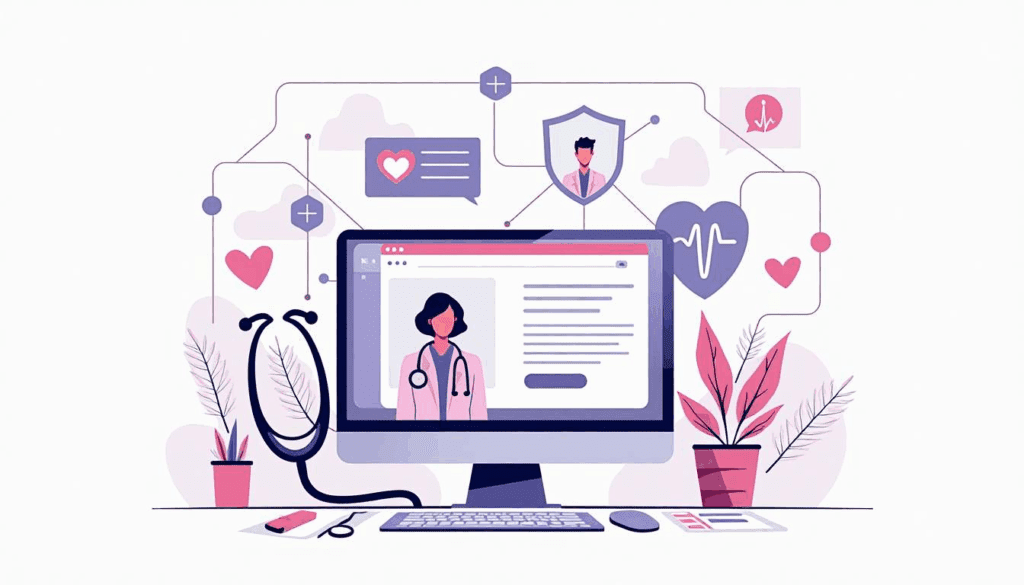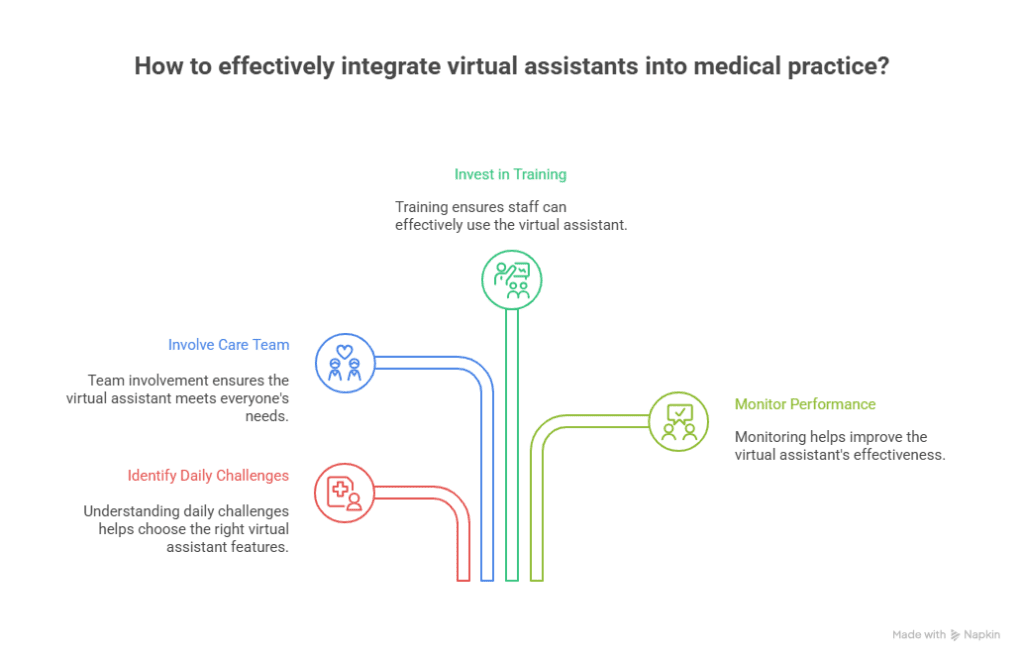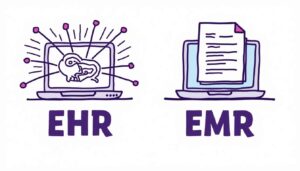Virtual Assistant for Doctors: What You Need to Know
04 Aug 2025 By: Mary Dellosa
Updated

Healthcare keeps changing, and many doctors now get help from virtual assistants. These are real people who work from home to handle admin work, talk to patients, and give support. They help doctors save time, lower stress, and focus more on care. This guide explains what a virtual assistant for doctors do, why they help, and how to use them well. Whether you work alone or in a big clinic, they can make your day easier and your care better.
What Are Virtual Assistants for Doctors
Defining Virtual Assistants for Doctors
Virtual assistants for doctors are real people who work from home to support busy medical teams. Unlike office staff, they help remotely and know medical terms, rules about patient privacy, and how clinics run. They connect through calls, email, or EHR systems to keep things moving.
Virtual assistants are the extra pair of hands every doctor wishes they had. They send gentle reminders, jot down notes, and keep records tidy. Working quietly behind the scenes, they lift the load so doctors can take a breath, look patients in the eye, and truly listen. It’s not just support—it’s care made easier.
How Virtual Assistants Differ from Other Healthcare Technologies
While tech like EHRs and telehealth tools has changed healthcare, human virtual assistants bring something extra real help with a personal touch. They bridge the gap between doctors and digital systems by handling tricky tasks with ease. Instead of clicking through charts, a doctor can just ask for lab results or past meds, and the assistant finds them fast. Reliable connectivity plays a quiet but important role in making this possible. Many virtual assistants work remotely and rely on secure, always-on access to healthcare systems, even when working across locations or time zones. In these cases, tools like eSIM can act as a dependable backup, helping ensure communication, data access, and patient support continue smoothly when traditional internet connections aren’t available.
What makes them different is how they think ahead. They don’t just wait for commands they offer help based on past chats and current care rules. That saves time and helps doctors make smart choices quickly, which means better care for patients.
As telehealth grows, virtual assistant for doctors matter even more. They track data from wearables and flag warning signs early. This helps doctors act fast and makes patients feel seen, even from home. Tools like the MAP calculator can also be used alongside these insights to monitor blood pressure health more closely. It’s real-time support that keeps care connected, even at a distance.
Key Benefits of Virtual Assistants for Doctors
Reducing Administrative Burden
Doctors are here to heal, not drown in paperwork. But most days, forms and files take over their time and energy. Virtual assistant for doctors step in to help. They handle calls, notes, and billing quietly keeping things on track. This gives doctors more time to care, listen, and connect.
With their help, doctors can slow down, look patients in the eye, and really listen. It’s simple support that brings the heart back to healthcare.
Enhancing Patient Communication
Patients don’t stop needing care after a visit. They just want to know someone’s still there. A warm message or gentle check-in says, “You still matter.” Doctors want that too, but their days are full. That’s where virtual assistants step in. They send gentle reminders, follow up after visits, and answer simple questions.
They spot what’s important. If something feels wrong, they alert the doctor. If it’s small, they handle it with care. With their quiet support, patients feel remembered not left behind. They know someone is still there, still looking out for them.
Supporting Clinical Decision-Making
Some virtual assistant for doctors do more than just help—they think ahead. They watch for things like bad drug mixes, missed tests, or strange lab results. They work with the doctor’s systems and trusted medical info to help spot problems early. In 2022, almost half of doctors using them said they made better diagnoses.
They also track patient health over time, so doctors can step in before things get worse. It’s like having a quiet, smart partner who’s always looking out for the patient too.
Popular Use Cases of Virtual Assistants in Medical Practice
Appointment Scheduling and Patient Intake
Virtual assistants help care feel easy and warm from the start. No more sitting on hold or juggling forms patients can book, reschedule, or cancel with ease. They ask simple, caring questions how you’re feeling, what you’re taking so your doctor walks in already understanding you.
No delays. No mix-ups. Just a visit that feels calm, personal, and prepared. And with every small step, clinics learn more about what truly helps their patients feel seen and cared for.
Medical Documentation and Transcription
Writing notes takes up hours doctors wish they could spend with patients. Virtual assistants step in to help, quietly listening and recording key details during each visit. They fill in charts, cut down on typing, and help catch things that might get missed. Doctors can review or adjust notes later, even from home.
And the more these assistants work, the better they get. They learn how each doctor speaks and what matters most making records more accurate and care more personal.

Medication Management and Prescription Support
Taking medicine can feel hard. You might forget or feel unsure. That’s okay. Virtual assistants are there to help, gently and simply. They make sure your meds are right and safe. They send kind reminders like a soft voice saying, “It’s time. You’re doing great.”
If you’re confused, they explain things in clear, simple words. No pressure. No stress. It’s like having someone kind by your side, making sure you’re okay and never alone.
Remote Patient Monitoring and Follow-Up
When care happens at home, it’s easy to feel alone. Virtual assistants help change that. They gently track things like blood pressure or sugar levels and quietly alert the doctor if something doesn’t look right. They check in with kind, simple questions “How are you feeling today?” so nothing gets missed. If something’s off, help comes sooner, not later.
They make it easier for patients and doctors to stay connected. A quick message. A small change. It’s a small thing, but it matters a gentle kind of peace. With virtual assistants, patients don’t feel alone. Someone’s there, in the background, making sure they’re okay.
Challenges and Considerations When Implementing Virtual Assistants
Data Privacy and Security
Patient stories are personal. Every blood test, every symptom, every fear—it’s private. That’s why keeping it safe matters so much. Virtual assistants must follow strict rules, like HIPAA or GDPR, to protect that trust. They use locked systems, hidden names, and strong codes to keep data safe.
Doctors and clinics should ask hard questions before they choose a tool. Who sees the data? How is it stored? Is it really protected? Checking often, asking experts, and staying alert helps make sure that what patients share stays between them and the people who care for them just as it should.
Integration with Existing Systems
For virtual assistants to truly help, they need to slide into the tools clinics already use. If not, things slow down and the team feels the strain. The best ones work smoothly with EHRs, calendars, and messages—no extra steps, no confusion just simple, steady support.
But the most important step? Ask the people using it—doctors, nurses, front desk staff what they need. They know where things get stuck. When they’re part of the choice, the change feels easier. The team feels heard. And care gets better for everyone.
Accuracy and Reliability
Virtual assistants try their best but sometimes they slip. They might hear something wrong or miss a small detail. That’s why doctors still need to be in charge. The assistant is just there to help, not replace. It’s a tool, not a teammate. That’s why they should support doctors not replace them. Human judgment still matters most.
To keep things safe, clinics should check the work often, train staff well, and keep systems up to date. Letting users share feedback also helps fix problems and make things better over time. With care and teamwork, virtual assistants can keep growing and keep helping, in ways that truly support both doctors and patients.
Cost and Return on Investment
Starting with virtual assistants takes time and money, fees, training, and sometimes new tech. For small clinics, that can feel like a big stretch.
But over time, they can take a real load off. They help with paperwork, save time, and let doctors focus more on people not screens. That relief can be worth a lot. Even the little wins matter. One less missed visit. A note done faster. A patient who doesn’t have to wait on hold. That brings real ease to a busy day.
Best Practices for Integrating Virtual Assistants into Medical Practice

Start with Clear Objectives
Before using a virtual assistant, doctors should think about what’s hardest in their day. Is it too much paperwork? Missed calls? Trouble with med lists?
Knowing what feels hard each day helps you choose the right kind of help. If calls pile up or the schedule’s always full of gaps, that’s a good place to start. Maybe you need an assistant who can answer patients kindly and book visits without the back-and-forth. When the help matches the need, the whole day feels lighter.
Involve the Entire Care Team
To make virtual assistants work, everyone needs to feel part of it doctors, nurses, front desk, and tech folks too. Ask them what’s hard in their day. Listen. Their ideas help shape the right tool.
Even a quick chat or simple meeting makes people feel heard and included. It’s not just about using new tech. It’s about working as one team to make care easier for everyone.
Invest in Training and Support
Training is key. Everyone—doctors, nurses, staff should learn how it fits into their daily work. When each person knows how it helps them, it feels easier to use and more useful too.
It also helps to listen. Let people share what’s hard or what could be better. With feedback and support, the assistant keeps improving—and so does the care.
Monitor Performance and Patient Feedback
It’s good to pause and ask how’s the virtual assistant really helping? What’s working? What’s getting in the way? Ask your team. A simple question can bring clear answers. When people feel listened to, things improve. And care starts to feel a little easier for everyone.
The Future of Virtual Assistants in Healthcare
As more care happens from home, human virtual assistants will become even more important. They help patients feel connected and help doctors stay close, even from far away. With tools like fitness trackers and simple check-ins, virtual assistants can quietly spot small changes like a rising heart rate or a missed dose.
They notice the small changes like your heart beating a little faster—and softly raise a flag before it becomes something to worry about. It’s like a quiet, caring presence beside you. Not loud, not pushy just there. Watching out, making sure you’re okay, even when you’re not thinking about it.
With care, trust, and good design, these helpers will keep growing into kind, smart partners in every patient’s health journey.
Trending Now
Physician burnout in the U.S. remains high due to long hours, lost autonomy, and heavy admin loads. These stressors often start in medical school and persist through practice. Doctors face emotional exhaustion, less time with patients, and rising depression rates. Work-life imbalance is worse in medicine than other fields, especially for women. The COVID-19 crisis deepened the problem, as doctors worked harder without proper support, leading to a steep drop in mental health.
Organizations like the AMA and ACP have launched programs to reduce stress, but their impact has been small. Many doctors feel these efforts don’t fix the root problems. Hospitals try wellness programs, but burnout rates haven’t changed much in a decade. EHRs cause major frustration, and little has been done to improve them. True change needs major reform—less admin work, better EHR systems, and restored autonomy. Without that, burnout will continue.
Conclusion
Human virtual assistants give doctors something simple but rare—more time to care. They take on the small tasks writing notes, sending reminders, answering messages so doctors don’t have to do it all.
They don’t replace the human touch. They make room for it. They help doctors slow down, look up, and truly be there. In a busy world, these quiet helpers bring the focus back to what matters most patients, people, and real care.
Take the weight off your team. HelpSquad Health friendly virtual assistants handle tasks like chat, admin work, and customer support so you don’t have to. Less stress. More time. Real support. Try HelpSquad Health today and see how simple great help can be.


